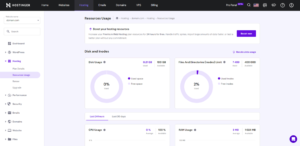How to Ensure Maximum Uptime for Your Web Hosting
Uptime is one of the most critical factors for any website. It determines the amount of time your website is accessible to visitors without interruptions. Frequent downtime can harm your site’s reputation, lower search engine rankings, and lead to revenue loss.
Here’s how you can ensure maximum uptime for your web hosting and maintain a reliable online presence.
What is Uptime, and Why Does It Matter?
Uptime refers to the percentage of time a server hosting your website is operational. For instance, a 99.9% uptime guarantee means your website could be offline for approximately 8.76 hours annually.
Why Uptime Matters:
- Customer Trust: A website that is frequently down can frustrate users and reduce trust.
- SEO Rankings: Search engines penalize sites with poor uptime records.
- Revenue Impact: For e-commerce sites, downtime directly translates to lost sales opportunities.
Factors That Affect Uptime
- Server Hardware and Infrastructure
Reliable hardware and robust infrastructure minimize hardware failures and improve uptime. - Network Redundancy
Multiple data centers and redundant network paths ensure continuous availability, even during maintenance or outages. - DDoS Protection
Downtime caused by cyberattacks like DDoS can be mitigated by advanced security measures. - Server Location
Hosting your site on servers close to your target audience improves speed and reliability. - Maintenance Schedules
Proper server maintenance prevents unexpected failures, though it may require minimal downtime.
Tips to Maximize Web Hosting Uptime
1. Choose a Hosting Provider with a High Uptime Guarantee
Look for hosting providers offering at least a 99.9% uptime guarantee. Some top-tier providers even offer Service Level Agreements (SLAs) that provide compensation if they fail to meet their promises.
2. Opt for Managed Hosting Services
Managed hosting providers handle server maintenance, software updates, and security patches, ensuring your server runs smoothly.
3. Use Uptime Monitoring Tools
Monitoring tools can alert you in real-time if your site goes down.
- Popular Uptime Monitoring Tools: Pingdom, UptimeRobot, and StatusCake.
- What to Monitor: Response time, downtime duration, and server issues.

4. Invest in Redundant Hosting
Redundancy minimizes the impact of hardware or network failures by hosting your website on multiple servers. Options include:
- Cloud Hosting: Scalable resources across multiple servers.
- CDN Integration: Content Delivery Networks cache your site’s static content to ensure availability, even if the main server is down.
5. Regularly Update Your Software
Outdated software can create vulnerabilities or compatibility issues, leading to crashes. Regular updates to your CMS, plugins, and server software help maintain stability.
6. Implement Robust Security Measures
Cyberattacks like malware injections and DDoS attacks can take your website offline. Secure your hosting with:
- Web Application Firewalls (WAFs).
- DDoS mitigation tools.
- SSL certificates for encrypted communication.
7. Schedule Maintenance During Off-Peak Hours
If maintenance is necessary, plan it during low-traffic hours to minimize disruption to users.
8. Monitor Server Resource Usage
High CPU, memory, or bandwidth usage can slow down or crash your site.
- Use tools like cPanel or server dashboards to track resource usage.
- Upgrade your hosting plan if you’re nearing resource limits.
9. Choose Hosting with Automatic Failover
Automatic failover ensures your site switches to a backup server if the primary one fails. This feature is common in cloud hosting solutions.
10. Communicate with Your Hosting Provider
Maintain regular communication with your provider to stay informed about server health, upcoming maintenance, and upgrades.
Best Hosting Types for Maximum Uptime
1. Cloud Hosting
- Why It’s Reliable: Distributes resources across multiple servers, minimizing downtime.
- Ideal For: Growing websites and e-commerce platforms.
2. Dedicated Hosting
- Why It’s Reliable: Your website has exclusive access to server resources.
- Ideal For: High-traffic websites requiring maximum control.
3. VPS Hosting
- Why It’s Reliable: Provides a balance between cost and reliability, with isolated virtual environments.
- Ideal For: Medium-sized websites needing scalability.
4. Managed WordPress Hosting
- Why It’s Reliable: Tailored specifically for WordPress websites, with optimized performance and security.
- Ideal For: WordPress sites that require consistent uptime.
How to Measure Uptime Performance
1. Uptime Percentage
Track your site’s uptime over a given period. A 99.9% uptime guarantee translates to about 43.8 minutes of downtime per month.
2. Server Response Time
Measure how quickly your server responds to requests. Prolonged delays can impact the user experience.
3. Downtime Alerts
Set up alerts with monitoring tools to notify you of any issues in real-time.
Conclusion
Ensuring maximum uptime for your web hosting requires proactive measures, including choosing a reliable hosting provider, implementing robust security measures, and monitoring server performance. By taking these steps, you can minimize downtime, improve user satisfaction, and maintain a strong online presence.
When uptime is a priority, investing in the right hosting solution and leveraging modern tools makes all the difference.



